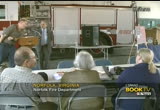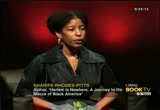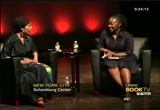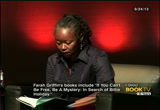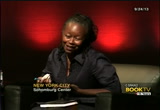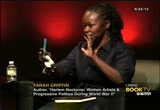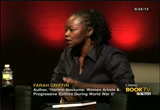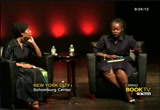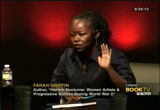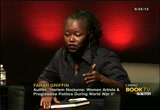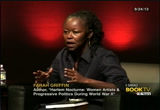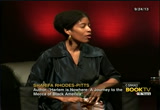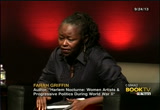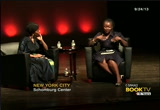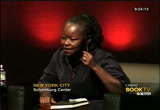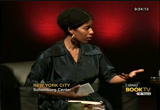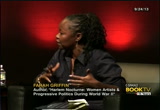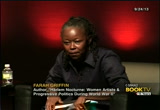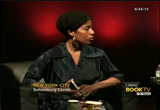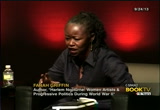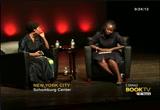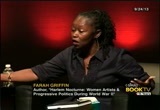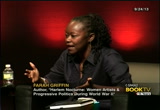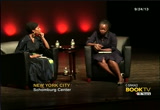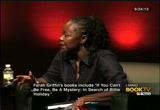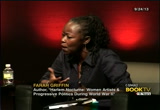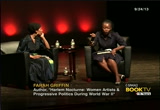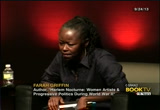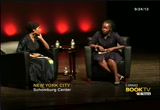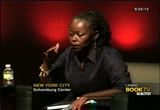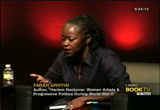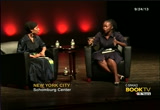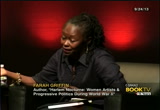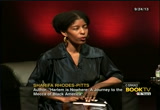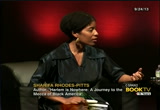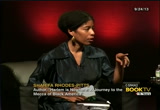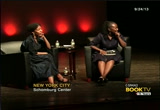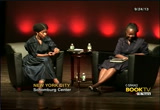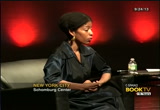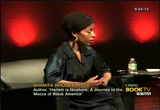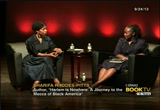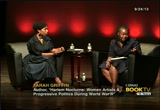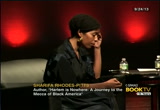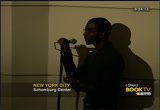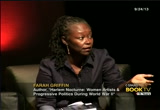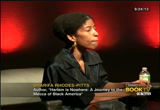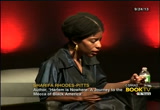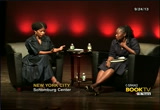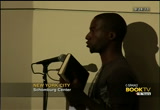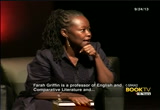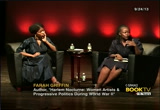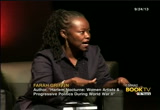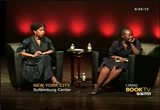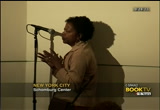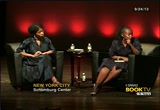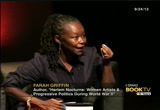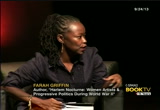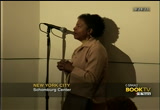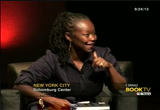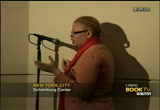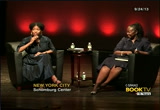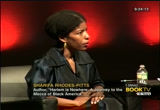tv Book Discussion on Harlem Nocturne CSPAN November 9, 2013 2:45pm-4:06pm EST
2:45 pm
growing. few would like to ask a question i can bring a the microphone to year-old then we will move to dinner. i have one question. after the book was published was there anything in particular you wish he would have left out or put in the book? >> no. there is always more you want to put into a book and you always find that moment where you find you could have written a better all fighters to that but there
2:46 pm
is always more that could be put in. >>. >> commandeers from the time you had to leave the department to get the book published how many years did this take? >> one year after i was disabled from the job and had a heart attack was the year i wrote the book it took 12 years to get the book published but an author writes with longevity in
2:47 pm
mind i had published several other books prior to this and i am always writing a new title all the time i have three books ready to go now and one book i wrote that many years ago as well glading to be published it is a combat war book from vietnam. it is in the same spirit of this one. >> it is great to see wonderful old friends and colleagues. i cannot tell you what a great thing if it is. >> my question is from your vietnam experience out of
2:48 pm
curiosity have to be here are from vietnam? quite a few. >> talking about your bronze star would it bother you to tell you how you got it? mcfadyen said good question. i was of the first recall a marine corps combat for a man and we bade enemy contact and were surrounded and my patrol leader was wounded. we actually granted to the end of the point man then this guy opened up a everybody is shooting at each other the first person it was my patrol leader event we would try again to
2:49 pm
the perimeter and we waited for the choppers and that is the simple the answer to that question. anybody else? >> i did not even know i had the bronze star and tell i was out of the military and they sent it to the in the mail. [laughter] >> tavis certain schedule for writing your books? >> i write every day i a very disciplined that is why i could keep writing other books thank you for the question i believe we are out of time.
2:50 pm
2:51 pm
[applause] good evening thank you to farah for inviting me. i told her the story privately but i want to share it when i was an undergraduate at harvard, 18 years old taking a survey course of african-american literature event he was absent for one session and the replacement for this session was farah griffin who was us color that year.
2:52 pm
this was incredibly wonderful because that your teeeighteen was that he is to tear it -- was that the institute it as an 18 year-old to was over the moon i was zero throat and inspired of the work of these young scholars. the day that farah came to our class we were studying one of my favorite book site thought it was so moving she was giving it wonderful guidance but the first time i was taught literature by a black woman besides my mother who was my first introduction but it was a moment that i felt that should be marked. and you have continued to
2:53 pm
inspire me. when you teach a lecture class you don't know who was sitting out there and it turns out this extraordinarily talented young writer that i would be later without knowing she is a student in the class. figure. >> host: i wanted her to ask about the introduction of the way she brings the women onto the page. >> guest: i will find my way around. new york back in san they came. one came as a child brought by immigrant parents the other as a live-in seeking freedom if they were shaped by the city with the movement of their bodies and
2:54 pm
they walk and listen they dance and then they came. new york told them anything was possible with new boundaries. although the city welcome them as residents there were not always received with enthusiasm so and some point they all lived in harlem board of the migration of black people from the caribbean and american south the anti-black fallen -- violence erupted in the entrepreneurialism energies. harlem. raise capital the immigrants daughter moved to another neighborhood in brooklyn. harlem, who wanted to live anywhere else?
2:55 pm
but they would like to have the choice so they protest the limitations meanwhile helping to build a city within the city speaking a multitude of languages making music and new people. it was the city of changes of brown face children some enraged a city that dances and the lindy hop and african isolation. [applause] >> what was your first introduction? immelt the book is about three women a jazz pianist
2:56 pm
and a composer and ann petri the writer i was introduced to each at various stages as a student as an undergraduate at harvard. i started to read and peachtree and her books would be reprinted for the first time. so they encountered them as a graduate student and later whose work i have the longest relationship with and i have the opportunity to meet her. the dancer choreographer i first encountered through people like of picture book
2:57 pm
that would tell me about these wonderful women and a book like brown sugar was a way to know her as a figure before a dancer and choreographer and to bury the williams added that no although i grew up warehouse jazz was played all the time i did not encounter marylou williams until i was an adult during the time my started to study about women's contribution to jazz music aside from people like billie holiday. i discovered the latest of the three women but also fell in love with her but i am biased so i am in love with all of them. [laughter]
2:58 pm
>> host: what was the moment you wanted to tell their story together? >> guest: i actually discovered or thought about telling their stories together here at the schomburg i was a fellow when i wrote the book but the idea was born when i first moved to york around 2001. there was some small projects i was engaged in here at the schomburg center but i was writing notes for the issue of illegal foreign cd and a completely over research and i thought this was an interesting era and '03 with and are important. i have a forecast of characters and they were the three who survived. >> host: can you talk
2:59 pm
about this time period? it is an interesting moment that does get lost with our popular imagination because it comes after the harlem renaissance from the it great depression and as prominent voices in a powerful way. >> guest: you are right we were talking about this that harland is constantly always exciting within the historical decade you can put your finger there and you did that with your work with the contemporary bill meant that the '40's were fascinating and everything is overshadowed there's so
3:00 pm
glamorous and talented they tend to overshadow everything but the '40's were vibrant period you enter it coming out of the depression with a little bit of prosperity and it is a period of the second straight migration so all these people coming in and found it is the lindy hop for the birth of be-bop the period that malcolm x plates about when he first comes to harlem or miles davis so before they become the e -- the icon they walk the streets of harlem so that is a fascinating period unlike
3:01 pm
3:02 pm
>> or who are making access to certain publishing houses and things like that available. i think in the '40s what you get are people who are much more self-consciously politicized. not that the earlier moments aren't, but these are people who, artists who are coming of age in a period where there is a, there's a kind of activist momentum, and they see themselves very consciously as part of that activist moment. so that the institutions, it's not so much individuals who are offering patronage to them, but there are institutions that are providing venues and places for them to publish and perform. and many of those institutions actually come out of a sort of more radical sensibility from the 1930s. their artistic organizations or publications, but they see themselves as having a kind of
3:03 pm
social action mission, you know? >> and what about the political consciousness of these women? because they unfold in different ways. >> right. >> and you talk about that in the book. someone like mary lee williams doesn't -- well, she does consider herself an activist. put some distance between the more tradition always of defining her work as political. >> absolutely. i mean, i think that they -- i wanted to show, one of the reasons why when i was narrowing down and i decided on these three is, one, i i wanted to show a range of engagement in different art forms, but also i wanted to show a kind of continuum of political engagement and involvement. so someone like a young dancer who's a student at hunter college who joins various kind of political organizations while she's a student and is probably the most, you know, what we think of as conventionally radical of the three, actually
3:04 pm
joins the communist party for a while. and so that helps to shape her analysis of the world, so that would be -- and then someone like ann petri who's a writer who is surrounded by people who are radical political activists and respects and admires and defends them when they come under assault, but also keeps her distance and, you know, doesn't join -- she's not a joiner, she doesn't join organizations. she won't call herself a maxist or a -- marxist or a communist. she has sort of a left-leaning sensibility, but she doesn't like to be labeled or boxed in in a particular way. and she is very active. i mean, she's engaged in various forms of activism. and then someone like a mary lou williams, i think, who says, you know, her interest is always in how can she be of assistance to people who are in need. and sometimes that might be people who are in need because of their poverty, and it might be through individual acts of
3:05 pm
philanthropy or supporting certain kind of activist activities, or it might be fellow musicians who are having issues with drug addiction. and she becomes a kind of one-woman rehab center or something. so they all have, you know, they fall along a kind of continuum and are brought to sort of what we think of as a political consness through -- consciousness through very different means. >> and how then does that express itself in the work? because i was looking for pry miss moving, a hard thing to find, but i did find some things. i also have a dance -- [inaudible] background, actually, and all i ever saw was the leap, that fantastic leap. but i'm thinking about something you do really beautifully in the book where you talk about different kinds of movement, pearl premise specifically as a mover. the movement and music, the idea of a movement through a phrase
3:06 pm
of music or a piece of music, a movement through a literary work and then the actual movements that people find themselves engaged in or living alongside if not directly engaged in. what -- how does the work itself express that or sigh away from it? -- or shy away from it? did they keep it separate, and is it possible to separate them? >> that's a good question and a difficult one. i think that one of the things i try to stress is that even though they are political agents, and they're involved and see themselves as involved in a certain kind of political work, they are, all of them, are first and foremost artists. and their art forms, i mean, they have, you know, they define that differently. but they really are trying to find ways for the expression of their creative ideas. and so it finds its way in the
3:07 pm
work, and for someone like -- [inaudible] she starts taking dance can lessons at a place called the new dance group which was founded to use dance as a way of, you know, cultivating a certain kind of social activism. so she's already engaged in that process, and she's creating dances both that sort of narrate the stories of and the struggles and the difficulties of black people, but also celebrate the joy of black people. she tries to create a dance, a kind of movement vocabulary that's informed by whether it's the dance of people many trinidad during cash -- in trinidad during carnival or sharecroppers in the south, she's really creating a kind of dance vocabulary that tells those stories and sees dance as a way of educating people about, you know, the experience of people of african descent.
3:08 pm
and for ann petri i think it really does, it comes about in the forms she chooses. in some ways she's writing within a kind of social realism, you know, mode. but she also, i think, most importantly it's the people whose stories she chooses to tell. i mean, she's not -- she doesn't come from an elite -- i mean, she comes from a fairly elite background, but she chooses to tell stories about working class and working poor people. and to try and give a fully-networked portrait of them -- fully-fleshed portrait of them and their struggles. so in that way, that shapes her art. and with mary lou, it's a little more complicated, but i think she tries to, you know, she's very much invested in making sure that there's a certain history of black music in particular, that black music carries with it, bears with it a kind of archive and that she
3:09 pm
tries to make sure that that history is in the sort of contemporary popular music that she's playing and that it's also kind of informing its moment as well. it carries a history, but it also tries to shape its moment. so in those ways i think their social engagement, you know, you can see it or feel it in their art. but they aren't sacrificing sort of their creative expression for the sake of their politics or their social consciousness. >> uh-huh. can i ask you a question about petri that i think it's always been there for me, but reading your book it really came into relief because you describe the world that she inhabits in harlem. you describe some of the worlds she inhabited literally on 116 street including the art center. >> right. >> and just that moment of you giving the address of whatever it is,116th street, i thought why isn't that on the street? why isn't the existence of a
3:10 pm
community art center in the street? >> i mean, that's one of the big questions about the choices that she makes. i have a theory, but it's only a theory. so ann petri writes a novel, for people who don't know it, it's published in 1946. it's about a female character who's separated from her husband. she's got a little boy. she's struggling to make ends meet. and it's a very kind of, you know, desolate view of what her possibilities are. and ann petri herself is very much engaged in a much more vibrant and diverse harlem than the one she represents in the novel. so this art center, for instance, that sharifa's talking about that produces, is a place where children can come and learn various forms of the visual arts and various artists are involved in it, petri and
3:11 pm
her son -- excuse me, the character and her son never have access to any of that. none of that is represented there. so in some ways i think it can be a critiquethat petri so insistent upon telling a certain kind of story that she flattened out certain possibilities of what's available to people who live in harlem. on the other hand, i think that -- and this is where i think that she's fully aware that there's so many people in harlem during her time that even though these resources are available that they don't necessarily know they are available, that they don't have access to them, that they aren't able to take advantage of them and that we can't take our eye off of those people who our sort of theories and activism, you know, sometimes we don't see them. and i think she wants to shed that light. so i think it's a real paradox in her work, you know? >> it's a paradox i can identify
3:12 pm
with. [laughter] in terms of what you choose to represent and what you don't. >> right. >> something someone told me when my book came out, it was people of a certain class in harlem feel like i didn't represent them. >> right. >> i won't go into any details. [laughter] read between my lines. >> no, i think, i understand that. and i think that was, you know, you probably can identify with petri, that was a criticism that petri got also. i mean, when we think about, you talked about the difference between the harlem renaissance and this period. when we think about the harlem renaissance, the books that were most championed or were books that represented the better class of negro, is literally what they would call them. and so the, petri and her generation of writers were not representing that version of harlem life or black life, and it's a consistent criticism at the time particularly from the african-american press that she
3:13 pm
is not representing the best of the race, so to speak. right. so, i mean, i'm sorry to hear you had to deal with the same thing, but there's a long history of that kind of critique. >> and what about the reception of her work and the other women? >> one of the things that i was fascinated by when i did the research is that i, you know, you have these assumptions that you bring to a project. and so i assumed, oh, this is interesting. all of them are working during this period. and because they're black women, they probably are not getting any attention for their work. and that's why so many of us don't know about them today. and what i discovered here at the schomburg reading through microfilm because not everything was online yet was that i was absolutely wrong and that all of them actually got a tremendous amount of attention for their work. petri was widely published. i mean, widely reviewed in both the black press and the
3:14 pm
mainstream press and the left-wing press. pearl primus was the darling of "the new york times" dance critic, john martin, who was a very powerful man at the time. mary lou williams had a radio show, had -- her long works would premiere at town hall. so they actually had a great reception, a reception that i really, i couldn't have imagined that they had. and then they sort of fall off of the radar later on. so, now within that reception there's a variety of responses to them, so some people are celebrating ann petri's work, some people in the black press are saying, oh, it's too downtrodden. some people in the left press are saying that it's not revolutionary enough because it doesn't provide a political way out. so there's a variety of responses, but at least the work is being attended to seriously, which is what we all want. we want our work to be attended to and to be recognized.
3:15 pm
so they get the recognition at that time. >> one thread that goes through the book is the double v movement, victory at home and abroad for civil rights. at home and victory against fascism abroad. it's something that all three women encounter. >> right. >> and reflect upon. and it made me think about these different levels of their, of their political concern. there's the super local, community-based concerns, think of them as race women, just thinking about the situation in america generally and then there are global concerns. i wondered if you could talk a little more about conceptualizing their work into a contemporary movement, the reference to harlem and also the global political movements. >> i think of the three at that particular time, of the three pearl primus is most, probably
3:16 pm
most articulate about a kind of understanding of global issues particularly as they relate to people of african descent. most vocal about seeing the war against segregation, you know, the fight against segregation -- and this is, you know, during kind of the height of jim crow, so they're fighting against jim crow -- but she absolutely sees that not only as a fight that's a fight that's necessary for democracy in the united states and a fight that's necessary for democracy, you know, kind of against fascism abroad, but with her she, she's also always cognizant of what's going on in the caribbean and africa before she even visits africa, right? she also, i mean, she comes out of a household that is kind of a garvey-based household. if they aren't card-carrying g
3:17 pm
garveyites, they're very aware. so she has this global sensibility. and it's most apparent in what she says and in her work, and it's, you know, less apparent in what's going on with petri and with mary lou williams although all of them recognize the kind of local struggles that they're involved in as being struggles that are about the question, larger questions of democracy. and they're all linking issues of race with issues of poverty and class, right? they haven't, none of them are separating those two things, right? that they see the struggle against jim crow not only as a way of freeing african-americans, but as a way of freeing this nation at the same time that world war ii is claiming to free the world in some ways. yeah. >> i was thinking about their
3:18 pm
moment and some recent discussions that have happened about artists being politically engaged or not and coming from harry belafonte who was a contemporary and who was informed by some of these same halls and conversations really. and could you talk a little bit about that, the context that gives rise to a generation of engaged artists versus the lack of context that might exist for that today? and really i'm interested in kind of tracing the line of, like, where it got dropped. >> yeah. >> or not. >> complex set of issues there. [laughter] it's funny that you mentioned harry belafonte, because he did, he actually is someone who knew all three women in different ways. he actually ann petri was part of the american negro theater right here in this building, and
3:19 pm
she, so she knew poitier and belafonte and ruby dee and ozzy davis, and that's part of that generation. we think of them as, you know, very kind of socially active, politicized artists. one of the things i think that was clear was that none of them -- and i see this with the women -- none of them were kind of sitting back saying we're going to strategize and build a movement, right? as artists. that we're going to sit back, and we're going to strategize, and we're going to build a movement. i think that they came along at a time when the long, what we think of as the long black freedom movement, you know, had a breath -- a new breath. and it was happening, right? it was, this is also a time when ella baker is living in harlem. i mean, there's a lot of ongoing
3:20 pm
political activity. and so there's already a movement in place whether it be through double v, whether it be through what adam clayton powell was doing, there's already a movement in place and that these or artists find their place in that movement. it's, you know, it's the movement that embraces them, that they then acquire a certain sensibility and analysis. if you hear harry belafonte talk today, you're struck by his level of analysis, right? and so i think instead of being so hypercritical of contemporary artists for what they do and what they don't do, i also think that they aren't in a moment where there's a kind of heightened political activity on the part of any of us, right? that that -- it's not a moment of that kind of political movement. and i think if it were, it might produce a different context, and it might produce a different set of responses from the artists themselves.
3:21 pm
>> um, i wanted to shift gears a little bit. i was just thinking about mary lou williams, she's the artist of the three that i knew the least. i know a little bit of her music and listened to some in reading your book. can you talk about writing her life after having done the work with billie holliday and, you know, your different approaches to music, just writing about music and how do you -- i always find it's the most challenging thing. in fact, i didn't write about music in harlem. i was a big failure. but i'm just curious how you inhabit the music and what that's like for you. >> yeah. mary lou williams was so intimidating to me to write about, and i initially wanted to write about her, and then i decided that i wouldn't. and the reason why i wouldn't was because i didn't think i knew enough to write well about her music. and then i had, you know,
3:22 pm
friends and colleagues who said, well, then that's why you should write about her, because you choose -- sometimes it's good to choose subjects that force you to grow and learn something that you don't know. and i felt most at home with billie holliday. i'd lived longest with her. and i studied her and had written about her. i think what i wanted to do was i wanted to, one, choose a woman who was engaged in the production of music who wasn't a singer. because we know the singers, we know some of the singers, and that's usually our way of, our way of thinking about women in jazz. and i wanted to try something else like what does it mean to think of yourself as a composer and an arranger at this period in such a male-dominated way. and i also, you know, she -- all three of these women, i think, their sense of themselves was just so incredible to me. and especially mary lou williams. i mean, there were so few
3:23 pm
examples for her of what it was she was trying to become, and most of those examples were male. and yet she pursued it, she had absolute confidence in her talent and ability and importance. and so i think that i just, i sort of learned to welcome the opportunity to try and learn how to write about her. and how to write about the music. and then it just was a process of listening and listening and listening and trying to really write down what it was that i heard. and it was such a moving encounter. i mean, if you don't know her music, i strongly recommend -- i hope this book will make people listen to her. it was such a moving encounter and so powerful to me that i just decided to write about that element of it. that, you know, that there's something very soulful about her music and very ambitious.
3:24 pm
she's an incredibly ambitious writer and and arranger. and she -- i loved her because she thought, ah, duke elington is writing these long forms and he gets a concert at carnegie hall, why not me? and so she does it. yeah, i'll just say that. she was the biggest challenge and the one from whom i think i learned the most. yeah. >> i loved reading about her coming uptown and stopping in minton's. can you, for the people who haven't read the book, just talk about that moment that she's a mentor to the bee boppers. >> so she's the oldest of the three women at the time of the book. by the time she moves to new york, she's already very well known. she's been called the lady who swings the band with the andy kirk orchestra, she's arranged for duke elington. so she's a star, she's a celebrity by the time she moves
3:25 pm
to harlem. so much so that newspapers like the amster or dam -- amsterdam news say mary rue williams moves to harlem. it's a big deal. and all the big musicians who are struggling are like, wow, mary lou williams is here. and they want her to hear their music. they want her to critique it, they want her to tutor them, and she does. she welcomes them. and unlike many musicians of her generation, she doesn't dismiss them, right? she's sort of the way that a max roach would have been with the hip-hop people, you know? with older musicians might have been like, oh, hip-hop is horrible, max roach was like, no, we have to listen and, in fact, embrace this. this is what mary lou williams was doing. and she's a star. and she's performing every night downtown at café society but before she ends up at home in her apartment in hamilton terrace,. >> she stops off at miton's because -- minton's because she's really excited by what's
3:26 pm
going on there. and it feeds her, and she actually hears some of what she's already been doing there as well. and she just thinks this it's ts whole new set of possibilities. and sominton's becomes -- it's a very important site for her and a very important site in the chapter about her. >> and what about some of the other sites of convergence? like you speak about the people of the voice paper which was founded by adam clayton powell or the new dance group. it just struck me that they even had these locations -- each had these locations, these bases which seems really important to the possibility of in this kind of work. and something that i think is lacking today in harlem. >> well, it's absolutely central. i mean, i don't think they would have been able to do what they did without those locations. so ann petri is writing. she writes a little for the amsterdam news, she sells ad space, but when adam clayton
3:27 pm
powell finds "the people's voice," he come comes on board there with a number of very interesting journalists. and it's the way she gets to know harlem. she's a reporter, and she has a reporter's eye, and she literally writes all of harlem. she writes from the high to the low about everything. it informs her fiction. it's a, you know, i mean i think now we think of certain spaces as being intellectual, and they're very narrow. we think of the academy or the classroom. all of these spaces had such incredible intellectual and political energy. so for her, for ann petri it would be "the people's voice." for pearl primus it would be the new dance group where she was taking these dance lessons and learning from martha graham and any number of people. and for pearl and for mary lou
3:28 pm
williams, it's place like café society, the nightclub where at any given night langston hughes and eleanor roosevelt might be in the audience. but it also, i mean, i i thisst the also -- i think it's also important to note where these women create their own spaces. mary lou williams also creates a space in her apartment which becomes one of the most important saw a loans for the development of bee bop music. so she brings that energy into her own home and opens up her home for that kind of place, you know, that kind of activity. what happens to them, i mean, i think one of the lessons of period be, again, is that these sites come under assault. i mean, they don't just disappear or grow out of fashion. as the decade gets more conservative and we get the kind of anti-communist fervor that comes at the end of the '40s and early '50s, there's assaults on places like "the people's voice" and on places
3:29 pm
like café society. and so those venues fold, and when they fold, you know, you no longer have those kinds of spaces to nurture the voices in the way that they would have in the earlier part of the decade. >> thinking about today's harlem, i'm always vexed with the celebration of restaurants as sites of possibility, like a restaurant not a site of -- i mean, it's -- i like going out occasionally, but i always feel like there's a, we are really detached from that kind of space making and what it's for. even the private kind, i think, is also something we need to initiate. >> i think, i mean, i would like to ask you, i have a question for you too about, you know, given that you documented this moment in harlem and this transition and change. that might be one of those changes, young? the celebration of a certain kind of opening of a restaurant as a space. i think that those spaces can become that, right? but they aren't necessarily
3:30 pm
meant to be that. like, what's fascinating about several of the spaces in the book are that it's the actual work and activity of the artists themselves that turn these spaces into something else, right? >> sure. >> but you're right, i mean, one of the things that also happens at the end of the narrative is something like the urban renewal act which really destroys our especially of continuity and community and gets rid of local establishments, local bars, local businesses where people can develop community and replaces them with something else. and that, you know, again, is one of those moments of transition. and then it's sort of like out of those ruins what does a new general ration create -- generation create. what comes -- and so one of the things that i, you know, in reading your work, i was reading sharifa's book just as i finished the first draft -- well, that's a high. there were many drafts.
3:31 pm
one draft -- almost the penultimate draft -- [laughter] i read her book and the first thing i thought was, wow, when someone writes another version of harlem focturne, her books will be one of the ones they study. but one of the things i thought about, from your vantage point what are some of the similarities and differences in what you see? you clearly know these periods to get to what you're writing. what's the major continuity or major difference that you see? >> gosh, i don't even know where to begin. i mean, the first thing that pops in my head is the research that i -- well, it didn't start out as research, but the experience that i had of being involved with the 125th street rezoning campaign which was ourly one of me just going to meetings, following signs to
3:32 pm
meetings and going there with a pen just to observe and going there because my friend, michael adams, said go there, you know? i wasn't very self-motivated. but i went. and it was a moment when i had been away from new york, from harlem for ant a year. and i came back, and i was just really aware of all of this change happening. it seemed it hit a critical moment. and so i became involved in that campaign. and after it was finished and after the campaign was with lost and 125th street was rezoned even though you don't see the physical, you don't see high-rise condominiums yet -- but it's legal to build them there now -- i was doing research again, and i found narratives of meetings that had happened in 1955 that were almost the same meeting where there was a plan in place to
3:33 pm
redevine 125th -- redesign 125th street. so i became aware of this cycle of questions that have been posed to this community and a consistent response from the community. so that's just one similarity. it was actually the same activity was happening 50 years later. and the way this community has been the subject of a reimagination or a plan, you know? >> right. >> okay. i'm being asked to wrap it up. >> okay. >> now, the differences? i mean, i think what you've raised about the spaces and the way that the work of individuals created those spaces is something for us to really consider deeply. as much as i can say flippantly that these restaurants are just places to go have a drink or, you know, they're also amazing
3:34 pm
institutions that exist like harlem stage which is nurturing incredible work and funding new work and other institutions. and, of course, the possibility of the schomburg and its revitalization and really, i mean, just the continuity that exists in this building is an incredible thing. >> right. >> you talk about some of the work that ann petri did was at the 175th street branch working with a theater group. so i'm always looking around and seeing, you know, on 138th street you can go and see the sign of where marcus garvey had husband first heating -- his first meeting in harlem. it's the first meeting room in a church or other spaces. i'm always interested in like what's that, what happened there, and i'm really interested in reinhabitatting those spaces. and there's projects that i have done or want to do, and i just am energized by the possibilities of those collaborations, you know?
3:35 pm
so that's, i guess, where my eye is. i've always spent time away. i lived this new orleans for two years which is a really amazing school for community and arts and politics existing all at the same time, as the same thing. and so i felt like i came through that, that place and returned to harlem with a new perspective of what was kneaded and what was -- needed and what was possible. >> it's possible. i think that's a great place to end, because even though the, you know, the narrative of harlem nocturne ends in the end of the '40s, beginning of the '50s where we get a kind of repression that comes onboard, i try to end it by showing that there are always a new generation that sees a new set of possibilities. so my women -- i call them my women. they're not my women, but they leave harlem, they leave new york, but a whole new generation comes. lorraine hasn't bury comes and
3:36 pm
maya angelou comes. and so there is, there is always kind of generating this sense of possibility. and then sharifa rhodes-pitts comes. it's all good. okay. [applause] so, questions? do we have time for questions, or are we done? >> i think there are time for questions, sure. i think there's a mic here, so if you want to ask a question, go to the mic. >> when you talk about the notion of place in harlem, you know, this new restaurant, the cecil and mintons, are just opening up. and it seems almost sort of
3:37 pm
prophetic to me that in preparation for the opening of these museums -- or, excuse me, for these restaurants the original neon sign for minton's mayhouse was taken off and given to the -- play mouths was taken off and given to the yet to be opened african-american museum at the smithsonian. and i would just like to ask both of you if you really seriously think that harlem can avoid becoming a praise where the schomburg -- a place where the schomburg is sort of like a synagogue in china town. [laughter] >> real. >> yeah, that's very real. >> michael, i've heard you express that before, and i think it's absolutely something anyone who cares needs to have their eye trained on. i also think as long as there
3:38 pm
are black people in the streets of harlem -- and i'm just hike, even as i say that, all these encounters i overhear and pass through and cross through in the most amazing poetic ways, like that is its own space making. and i have my own inner debate about, you know, i had a conversation with a friend about the -- we were looking at the renaissance ballroom, and you know really well the story of what's happening and what's happened there. i don't even know the up-to-date story of what's happening. but the renaissance ballroom being a space that was deliberately created by black people brick by brick to have a people to socialize and celebrate and have a business being blocked from landmark status, which is something michael fought against, in order
3:39 pm
that the corporation could make a condominium there. so i was talking to a friend about this, and, you know, here the very deliberate nature of that building and what it meant and that people subscribed brick by brick to build it, um, seemed to be a really dark story about our persistence here. and and my friend said to me, you know, that as black people we've always had to be fugitive in the way we inhabit space and the way our culture inhabits space. so i think there are different ways to live with that problem and to live with that question. it is dominated by capital, and the capital's not something we
3:40 pm
control. and the black people who control capital are interested in more capital. so it's not the first, it's not the first thing that people are trying to do. and the idea that people would go to a museum and that's a triumphant thing to be celebrated, unfortunately, we've all settled for our culture being -- or history. and not just black people's history, all people's history. we are quite used to that being the way things go. what were alternative possibilities for the cecil? what kind of space might it have been? i think as long as, i feel like that story was written, you know? >> i mean, i think -- well, for the audience, michael henry adams is one of the very important figures for both of us
3:41 pm
in terms of knowledge of harlem architectural history and activism. and i think, you know, that question is very real k it's not just real about harlem, it's real about all of these historic black places all over the country where we go whether they be in washington, d.c. or atlanta or, you know, any place where you -- central avenue in los angeles. and in some places harlem is one of the last strongholds because of what it's been to kind of hold on to a sense of historic identity. and it's a, i think what, you know, what's interesting about this moment and for some of us frightening and angering about this moment is that what you're talking about is a process that, you know, sharifa cites james wheldon johnson, i forget when that was, early 20th century when, you know, harlem is really the race capital saying that
3:42 pm
black people will not be able to hold on to harlem, right? he says that at the end of black manhattan. and so a prophesy with which we've been living, but i think none of us felt we would witness it in our lifetime. and i think what was so frightening and compelling about the question that you raise is that now some of us can actually imagine, oh, this could, this will, you know, this might happen in our lifetime. this might happen on our watch. so, i mean, i think that's the, both the richness and the fear of the question that you raise. >> and i also think importantly it's -- we have to keep in mind that it's not just a question about black harlem being black harlem, but, you know, the way i try to think about it and try to remind myself, force myself to express it is, you know, people who survived and built this neighborhood being able to stay where their families have been
3:43 pm
and a value being put on that kind of continuity. and it's not a value that is alive in many places around the world. so i think that's the thing that we must keep at the front of that conversation, that it's not so much that we want a sign to be there or we want people of a certain complexion to be here, but that doesn't it mean something if you're able to stay where your people have been? and the infuriating discussion that you see the you spend time on new york real estate blogs say things like, you know, well, if you can't afford it, why do you need to be there? there's just sort, there's a monster that sees its destiny to consume places and land.
3:44 pm
and we know that monster well. i don't know, like, what -- how to face it. i just know that isn't it about, like, people being able to live, people being able to enhance the possibilities for their life? and, yeah, i guess i'm just always struggling with myself about how to frame the question in a way that's meaningful, you know? and in so doing, hopefully have conversations and be able to make actions that change -- >> that change, that matter. >> hey. my question is about technology. interestingly enough, towards the end of this discussion you raised the question of how today's generation or the conscious artists for lack of a better world in today's world differs or is similar to those in the past, in the '40s and such. what are your guys' thoughts on how technology affects that equation? does it help? does it hinter? some people feel technology brings us closer and helps, some
3:45 pm
people feel like it draws us further away from issues and what have you. so just your ideas on that would be cool. >> yeah. um, yeah, i think it does both. i mean, there's always the kind of paradoxical nature of any technological change, and as black people we have a vexed relationship to it. [laughter] but i think at this moment it actually in some ways does both. i mean, technology -- if you think about things like social media -- creates possibilities, create a way of mobilizing that is unprecedented. and we see it, you know, we see it whether it's tahrir square or occupy or people mobilizing around stand your ground and trayvon. i mean, technology enables that this some ways -- in some ways, particularly social media enables that in some ways. and yet in other ways technology
3:46 pm
reinforces certain divides. i mean, who has access to it, you know, what -- it both creates community, but it also creates, you know, less contact between people. so i think the answer to your question is that it does both of those things at the same time. i don't know, sharifa, your thoughts? >> um, i'm just fiddling around in my head about the ways that people gather and thinking about the way these women gathered and the energy that they gained from their community. and i know that people gain a certain similar kind of energy from following someone on facebook or twitter or instagram, and you feel like you're there and everything. and i'm also interested in the ways that, how we define what kind of groups we belong to have changed so that the defining,
3:47 pm
the most important thing about you may not be that you're a black woman living in harlem in 1943. it might be that you're a person that owns these shoes and uses that app and buys these cool sunglasses. i'm sorry, not -- just glasses. you're a part of that community, but that's who you are. so i think that is maybe where some of the shift is happening, and it's something for a person like me who i just feel like i straddle something where just because of the year i was born i can kind of -- i remember pre-mtv and also have some access, but it's quickly disappearing, to a younger, a younger or generation. i think or my sense is that if we're just speaking about african-descended people, that is not necessarily the most important thing about a person today. >> right. >> that they're not, and i don't
3:48 pm
want understand it completely, but i'm just beginning to question my own assumptions that someone who is born in harlem today who has creative impulses who, you know, they may not define themselves according to these standards. so maybe that's the question. and how that is changing. is it just, is it that we have achieved our country as you quote -- [inaudible] saying? or have, like, so many things just been thrown into our path of more enticing than that, you know? so i guess that's my -- the question i'm constantly grappling with. i had a chance to visit with some university students earlier this month, and i really was just putting the question out there, does history even matter to you, you know? and i'm not -- and i think it does, but i think it's in a different way than i take for granted. >> thanks.
3:49 pm
>> hello. >> hi. >> first, i'd like to thank you for this book. it's a great read. >> thank you. >> so informative, and and there's so many just different things i'm going to, you know, pursue further because you have such great, detailed notes in here. also thank you both for your contributions to literature and culture and what you're doing. it's very important. many questions, but i too want to get back into the book, and i was very curious on pearl primus and her life and, you know, the work that she was doing. i feel like -- well, my question is how dangerous was it for her during this time? because i feel like that wasn't -- i didn't hear that story, you know? of her criticizing white america and jim crow, you know? like, what kind of resistance did she face? like how harsh was it? >> right. first of all, thank you for already reading the book. [laughter] appreciate that. one of the things that's interesting, and i think this is
3:50 pm
because she's here in new york and she's ensconced in a certain kind of community that she doesn't feel the sense of danger in the same way, right? that she's part of a kind of progressive political community of artists. she is -- in fact, one of the -- what she does before she leaves new york, she says new york is segregated, but it's not segregated with the signs, right? and she doesn't have, doesn't quite feel the limitations on her mobility in new york. so when she's about to go be south, she's really nervous because she's thinking i've never been south, aye never been -- i've never been to jim crow south. and so she writes various people through various networks including a group of young activists that the historian robin kellwrites about in his first book this alabama with affiliations to the communist party who take her in and take her up, right? and she takes advantage of these various networks.
3:51 pm
but the language that she uses -- and it really stands out to us -- is not language that she's the only one using at the time. and so what's interesting to me is that the danger we expect her to be experiencing in the 1940s she doesn't experience it so much in the 1940s. her use of that language and her engagement of those networks come back to haunt her later on with the rise of mccarthy. and it becomes -- you know, what becomes dangerous is what you said, with whom you affiliated yourself in the past more so than a kind of actual danger in her moment. it's a sort of political danger that then looks back and says who did you know and when did you know them and how did you know them, ask we're going to stop your possibility now because you said -- your mobility now because you said those things and did those things in the past. but that doesn't take away from the courage that she displayed during that period.
3:52 pm
so -- >> hi, good evening. i have a question. well, i was just very startled when you spoke about how these women were actually very celebrated in their time, and it was kind of a tragic moment to think we've lost them, so to speak. these aren't women who are celebrated in the same way that artists kind of before and after. do you think that's a function of the time in which they fall? is there something about these women and their art that caused them to kind of fall into historical absence? and to also follow up with that, do you think that we still are in that moment? do youdo you think that we stile the danger of letting artists that we celebrate die in the same way? do you think that's still possible today? >> i think that's always possible, you know? it's always possible. and the work who -- of who gets remembered is rarely about -- people will tell you these are classics because they're great works and they're universal, and there's some truth to that.
3:53 pm
but they're classics that generations that come later decide that they're worthy of keeping alive, and they tell us something we want to know about who we have become or because somebody has, you know, history is important to them, and this version of history is important. so what's happened with these women, i think, is, you know, they fall out of style aesthetically. there's a rise of new voices like baldwin and ellison, the early baldwin, that have a different perspective on america and what black people are in america that become -- there's more room for that perspective. you know, the fact that they're women has manager to do with it. and they -- has something to do with it. and they all, what i do like about their stories is the hurston story where, you know, she dies in obscurity and poverty and later on alice walker and other people rediscover her, that's not the case with these three women. they do fall sort of out of fashion, but a newer generation, the generation of the 1960s,
3:54 pm
the generation formed by black power, civil rights, the feminist movement really do kind of look back and say, oh, these are some foundational people, these are foundational texts. so that at the end of their lives before they all die, each one of them is celebrated for the work that she does and is recognized as a kind of foremother. because the younger generation does have a sense of history and what's important. so, i mean, i think that --st the work, not only the work of what you do in your moment, but it's the work of the generations who follow to insure a kind of life and a longevity and immortality. >> thank both of you for a wonderful conversation. one of the things i was very curious about a was the history of the period that shaped these women in terms of their political ideology, their
3:55 pm
activism and in the broader context something that michael talked about and what sharifa talked about is the space that we once occupied. >> right. >> and that citing james wheldon johnson we can't hold on to harlem. well, i don't know whether or not that's true if there is a resistance. so my question is given the political context of the time, that historical period contrast to today when people, in fact, are being pushed out and there are few alternatives for people who are being pushed out, why do you think that there is absent in this period a radical resistance as existed during world war ii where there was
3:56 pm
radical politics and it's very ideologically entrenched which is not true today. and there is this acquiescence to the inevitable, we can't hold on. and you give some political context for that in terms of contrasting the two periods? >> right. >> and what we have today that i think has had an artistic impact unlike anything that we have seen as this community, this historic black community is slowly dying. thank you. >> no, i mean, i think that -- thank you for many things, but for that question in particular. i think that thrfl -- there was a sense with this generation, with this group of women that there was no such thing as kind
3:57 pm
of inevitability or except the ineffort about was that they were engaged in struggle and that they would always be engaged in struggle. that they were, you know, that there wasn't fits of acquiescence, right? you might lose a battle, but it wasn't because you didn't fight it or because you accepted the inevitability of it. i think that all of them inherit, they come to this space during a time when it's come out of the depression where there are a certain set of radical possibilities and organizing possibilities and that harlem is not only, you know, they aren't looking at harlem as a space of cultural nostalgia. it's very much a vibrant cultural space where one is engaged in both a cultural, social and a political life, and that's shaping who they are. and i also think that what we see, i mean, what we're still dealing with is that we have
3:58 pm
unmeter -- inherited what was a conscious assault on those movements that they were a part of that then sort of resurrect themselves again later on, and then there's a conscious violet sort of repressive assault on those, you know, similar kinds of ideological sensibilities. that we see in, you know, kind of rearing their heads in the '30s and '40s, and then mccarthy, the mccarthy era and the conservativism of the mccarthy era closes those possibilities off. they come up again in the 1960s, other repressive acts. one of the things that i hope is that resurrecting this history will be a reminder of that legacy, you know? that that is a legacy, that is a set of possibilities that is available to all of us, and it is a birthright to all of us. so i think that's -- it's not that, you know, generations just fell asleep.
3:59 pm
i mean, i think there's an aggressive assault to foreclose those possibilities and foreclose people seeing them, seeing the possibility of fighting the inevitable. i hope that answers your question. >> it does. [applause] it did, it does. i hope that one of you ladies will get around to giving us a biography on claudia jones who was deported -- >> yeah. >> she settled this england, but -- in england, but she is of that period. >> absolutely. >> a truly epic woman. >> no, i mean -- >> in terms of her confronting the government and what was taking place. and one so rarely hears about her or any reference to her during the black history month, that one month that captures our -- >> everything. >> our lives. but i hope that someone someday gives this dear lady some
4:00 pm
justice. >> well, i recommend there's a book by a woman named carol boys davies which is actually about claudia jones, and it's the first book-length biography of claudia jones. you know, there were essays, angela davis wrote a series of essays, but carol boys davies actually does have a book, and for anybody, any particular young scholars or graduate students or young writers looking for a project, you know, i actually think that there's -- i have a triptick of women artists, but there's a similar book, a companion book that could be of the women activists that would include claudia jones or ella baker, all of whom were in harlem at this time. ..
4:01 pm
4:02 pm
just accept the slide of, you know, what are your thoughts on -- or your ideas, you know issue other than teaching our children what we can do to stop the -- not appreciation, but appropriation, you know, and i just -- one recent example that comes to mind, i didn't see it, but, you know, the mtv music video awards, you know, where -- it's, like, it was some kind of black theme, quote for a better example, r and b, but not one artist, not one black artist, one any awards either for hip hop, rap, or r and b, and then there was the infamous twerking incident. it's, like, we were remitted at the mtv awards by white artists
4:03 pm
who art was using our artistry to enhance their career, and what's scary to me is i see our young people, you know, picking it up, 12, 13, you know, justin bieber and justin timberlake and robin thinking aboute. they don't see black art itions, you know, and that's scary. i have to explain to them, you know, that r and b is started by black artists, rhythm and blues tells them about the history, what little i know, but just, your thoughts, if anything. thank you. >> i didn't see mtv either. the first thing that comes to mind is those kids that you talked to are hopefully, and
4:04 pm
probably definitely creating something new right now, and i just know i've been astonished watching, you know, people show me videos of the kids in l.a. dancing or in paris dancing. like, it's always on the move, and i think the part that is disturbing and always been disturbing as long as it's been happening is the money that follows the appropriation, and that the -- but at the same time, those kids in l.a. are trying to make money. we need to teach them how to make money off of what they are doing perhaps as well as teaching them the history of usefulness. it's, i guess, there's a critical consciousness about the industry and how to make money from art and always has.
4:05 pm
the main thing is, as i just think that it's always on the move, and our -- i don't know how much energy to spend on being offended by my lee cyrus thinking she's black. like, i don't know. [laughter] >> right. >> i absolutely agree. one of the things that drove me crazy. i didn't watch it, i don't care. i was sick of hearing about my lee cyrus. we have so much to do, stop wasting energy on this girl, what she's doing. i think that, you know, the cultural appropriation question is one that bothers us, absolutely, that cultures are, you know, they are borderless. i mean, we live right next to each other, always cultures informing and influencing each other, and you're right is that there's so much new produced that one of the things that black culture does is it is constantly on guard, constantly creating and recreating
86 Views
IN COLLECTIONS
CSPAN2 Television Archive
Television Archive  Television Archive News Search Service
Television Archive News Search Service 
Uploaded by TV Archive on

 Live Music Archive
Live Music Archive Librivox Free Audio
Librivox Free Audio Metropolitan Museum
Metropolitan Museum Cleveland Museum of Art
Cleveland Museum of Art Internet Arcade
Internet Arcade Console Living Room
Console Living Room Books to Borrow
Books to Borrow Open Library
Open Library TV News
TV News Understanding 9/11
Understanding 9/11